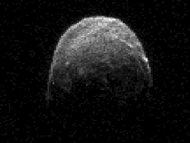Large asteroid nears Earth for rare fly-by

Astronomers around the world aimed their telescopes to catch a glimpse of the 2005 YU55 asteroid, which is about as big as an aircraft carrier but was not visible to the naked eye when it passed by at its closest point at 2328 GMT.
"Frankly, for anybody this is going to be really hard to see. This is 100 times more dim than what the human eye can see. You need a good telescope," NASA spokeswoman Veronica McGregor said before the fly-by.
The near-spherical, 1,300-feet (400-meter) in diameter asteroid often travels in the vicinity of Earth, Mars and Venus, but "the 2011 encounter with Earth is the closest this space rock has come for at least the last 200 years," the US space agency said.
Other asteroids of this size pass by Earth frequently, though the last such event happened in 1976 and the next will not happen again until 2028, when an asteroid called 2001 WN5 will skim about halfway between the Moon and Earth.
NASA said at the point of closest approach Tuesday, the 2005 YU55 asteroid "was no closer than 201,700 miles (324,600 kilometers), as measured from the center of Earth" -- roughly .85 times the distance of the Moon to the Earth.
The space rock's closest pass was expected to be off the Pacific coast of Central America, southwest of Guatemala City, as it travels in a northwesterly direction, McGregor said.
The asteroid "is one of the potentially hazardous asteroids that make close approaches from time to time because their orbits either approach or intersect the orbit of the Earth," said Robert McMillan, an associate research scientist at the University of Arizona.
McMillan discovered the asteroid in 2005 as part of the university's Spacewatch Project, a solar-system-scanning group of scientists near Tucson, Arizona.
However, astronomers knew from analyzing the trajectory of the asteroid that it would not hit Earth this time.
The asteroid's next closest pass is set to take place in 2094, at a distance of 167,000 miles, according to forecasts.
"The observations will give us a piece of the puzzle, one we don't get many chances to see," said Don Yeomans of NASA's Jet Propulsion Laboratory.
"At one time, we thought these were the asteroids that delivered carbon and other elements to the early Earth, so they are pretty important."
NASA said the Arecibo Planetary Radar Facility in Puerto Rico was tracking the asteroid as it closed in.
Astronomers at the Clay Center Observatory in Brookline, Massachusetts also trained their 25-inch (64-centimeter) telescope to track the asteroid and capture images of it.
NASA's Deep Space Network antenna in Goldstone, California grabbed radar images of the asteroid looking like a large gray egg, which were posted on the NASA website late Monday.
While the charcoal-colored asteroid's visit has scientists excited for the chance to get a closer look, most Earthlings probably would not notice a thing.
"The gravitational influence of the asteroid will have no detectable effect on Earth, including tides and tectonic plates," NASA said.
What the stars mean:
★ Poor ★ ★ Promising ★★★ Good ★★★★ Very good ★★★★★ Exceptional
Related Contents
Latest News
More News
- 72 nations sign landmark Hanoi cybercrime convention (October 26, 2025 | 18:00)
- UN Secretary-General commends Vietnam’s global leadership (October 26, 2025 | 09:00)
- APEC finance ministers convene to tackle regional challenges (October 22, 2025 | 17:31)
- Rewiring global trade: ASEAN’s rise as supply chain hub (October 17, 2025 | 11:40)
- Vietnam attends first World Nuclear Week Forum in Russia (September 26, 2025 | 10:50)
- Vietnam attends 69th session of IAEA General Conference (September 16, 2025 | 10:00)
- ADB, WB pledge over 12 billion USD for ASEAN power grid, renewable energy projects (August 15, 2025 | 14:18)
- Lowy Institute proposes AI-based tobacco control solutions for ASEAN (August 15, 2025 | 14:14)
- Cloud computing policy to position Malaysia as regional hub by 2030 (August 15, 2025 | 14:11)
- Thailand, Cambodia suffer numerous cyber attacks (August 05, 2025 | 16:19)

 Tag:
Tag:






















 Mobile Version
Mobile Version